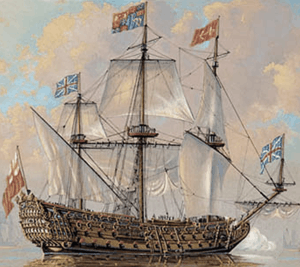HMS Royal Charles (1673)
HMS Royal Charles was a 100-gun first-rate ship of the line of the Royal Navy, designed and built by Sir Anthony Deane at Portsmouth Dockyard, where she was launched and completed by his successor as Master Shipwright, Daniel Furzer, in March 1673.[1] She was one of only three Royal Navy ships to be equipped with the Rupertinoe naval gun.[3]
 | |
| History | |
|---|---|
| Name: | HMS Royal Charles |
| Ordered: | 26 April 1671 |
| Builder: | Anthony Deane and Daniel Furzer, Portsmouth Dockyard |
| Launched: | March 1673 |
| Commissioned: | February 1673 |
| Renamed: |
|
| Fate: | Broken up, 1767 |
| General characteristics as built[1] | |
| Class and type: | 100-gun first-rate ship of the line |
| Tons burthen: | 1443 (bm) |
| Length: | 136 ft (41 m) (keel) |
| Beam: | 44 ft 8 in (13.61 m) |
| Depth of hold: | 18 ft 3 in (5.56 m) |
| Propulsion: | Sails |
| Sail plan: | Full rigged ship |
| Armament: | 100 guns of various weights of shot |
| General characteristics after 1693 rebuild[2] | |
| Class and type: | 100-gun first-rate ship of the line |
| Tons burthen: | 1657 92⁄94 (bm) |
| Length: | 170 ft 6 in (51.97 m) (gundeck) |
| Beam: | 47 ft 7 in (14.50 m) |
| Depth of hold: | 18 ft (5.5 m) |
| Propulsion: | Sails |
| Sail plan: | Full rigged ship |
| Armament: | 100 guns of various weights of shot |
| General characteristics after 1715 rebuild[2] | |
| Class and type: | 100-gun first-rate ship of the line |
| Tons burthen: | 1800 84⁄94 (bm) |
| Length: | 171 ft 9 in (52.35 m) (gundeck) |
| Beam: | 49 ft 3 in (15.01 m) |
| Depth of hold: | 19 ft 6 in (5.94 m) |
| Propulsion: | Sails |
| Sail plan: | Full rigged ship |
| Armament: | 100 guns of various weights of shot |
She was Prince Rupert of the Rhine's flagship at the Battles of Schooneveld; two naval battles of the Franco-Dutch War, fought off the coast of the Netherlands on 7 June and 14 June 1673 against the fleet of the United Provinces, commanded by Michiel de Ruyter.[4]
She was rebuilt at Woolwich Dockyard between 1691 and 1693, and renamed HMS Queen on 27 January 1693. The Queen became the flagship of Sir George Rooke and was captained by James Wishart.[5] She was rebuilt for a second time at Woolwich, relaunching on 20 September 1715, and renamed once more, this time as HMS Royal George.[2]
The much-rebuilt Royal George was renamed HMS Royal Anne in 1756, and was broken up in 1767.[2]
Notes
- Lavery, Ships of the Line vol.1, p161.
- Lavery, Ships of the Line vol.1, p165.
- Spencer, p.351; Endsor, p.9.
- Clowes, William Laird (1897). Book Viewer The royal navy - a history from the earliest times to the present (1897) Check
|url=value (help) (Vol. 2 of 5 ed.). Sampson Low, Marston and Company. pp. 310–311. Retrieved 1 April 2018. - J. D. Davies, ‘Wishart, Sir James (c.1659–1723)’, Oxford Dictionary of National Biography, Oxford University Press, 2004; online edn, Jan 2008 accessed 9 Dec 2012
References
- Endsor, Richard (2009). Restoration Warship: The Design, Construction and Career of a Third Rate of Charles II's Navy. Naval Institute Press. ISBN 9781591147121.
- Lavery, Brian (2003). The Ship of the Line - Volume 1: The Development of the Battlefleet 1650-1850. Conway Maritime Press. ISBN 0851772528.
- Spencer, Charles (2007). Prince Rupert: The Last Cavalier. Weidenfeld & Nicolson. ISBN 9780297846109.
- Winfield, Rif (2009). British Warships in the Age of Sail 1603-1714: Design, Construction, Careers and Fates. Seaforth. ISBN 9781848320406.
